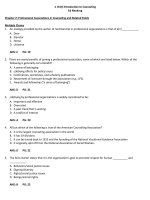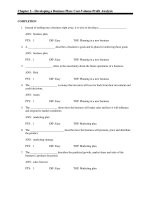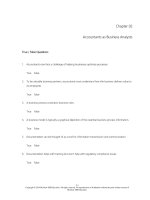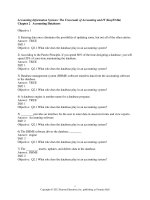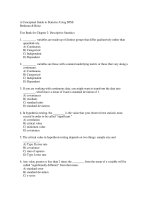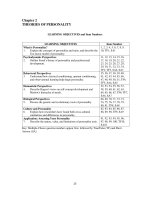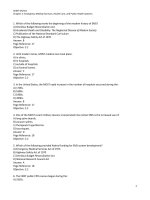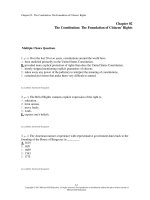ADJUST 1st edition weiten test bank
Bạn đang xem bản rút gọn của tài liệu. Xem và tải ngay bản đầy đủ của tài liệu tại đây (191.66 KB, 24 trang )
Chapter 2
THEORIES OF PERSONALITY
LEARNING OBJECTIVES and Item Numbers
LEARNING OBJECTIVES
What is Personality?
1.
Explain the concepts of personality and traits, and describe the
five-factor model of personality.
Psychodynamic Perspectives
2.
Outline Freud’s theory of personality and psychosexual
development.
Behavioral Perspectives
3.
Understand how classical conditioning, operant conditioning,
and observational learning help shape personality.
Humanistic Perspectives
4.
Describe Rogers's views on self-concept development and
Maslow's hierarchy of needs.
Biological Perspectives
5.
Discuss the genetic and evolutionary roots of personality.
Culture and Personality
6.
Explain how researchers have found both cross-cultural
similarities and differences in personality.
Application: Assessing Your Personality
7.
Describe the nature, value, and limitations of personality tests.
Item Number
1, 2, 3, 4, 5, 6, 7, 8, 9,
10, TF1, SA1
11, 12, 13, 14, 15, 16,
17, 18, 19, 20, 21, 22,
23, 24, 25, 26, 27, 28,
29, 30, 31, 32, 33, 34,
TF2, TF3, SA2, SA3
35, 36, 37, 38, 39, 40,
41, 42, 43, 44, 45, 46,
47, 48, 49, 50, 51, TF4,
TF5, SA4, SA5
52, 53, 54, 55, 56, 57,
58, 59, 60, 61, 62, 63,
64, 65, 66, 67, TF6, TF7,
SA6, SA7
68, 69, 70, 71, 72, 73,
74, 75, 76, 77, 78, 79,
80, 81, TF8, SA8
82, 83, 84, 85, 86, 87,
88, 89, 90, TF9, SA9
91, 92, 93, 94, 95, 96,
97, 98, 99, 100, TF10,
SA10
Key: Multiple-Choice question numbers appear first, followed by True/False (TF) and Short
Answer (SA).
25
MULTIPLE CHOICE
1.
ANS: c
OBJ: 1
2.
ANS: b
OBJ: 1
3.
ANS: d
OBJ: 1
4.
ANS: b
OBJ: 1
5.
ANS: a
OBJ: 1
What is the core concept of personality?
a. Being true to oneself
b. Traits shared with others
c. Consistency across situations
d. Being able to adjust to different situations
REF: 21
KEY: Factual
DIF: Easy
_____ refers to the combinations of consistent behavioral traits that are unique to each
individual.
a. Constellation
b. Personality
c. Dependability
d. Creativity
REF: 21
KEY: Factual
DIF: Easy
Like consistency across situations, _____ is also a central feature of personality.
a. Cognition
b. Personality
c. Consistency
d. Distinctiveness
REF: 21
KEY: Conceptual
DIF: Easy
“Honest,” “dependable,” and “friendly” are all adjectives that can be used to represent
a. personality theories.
b. personality traits.
c. personality tests.
d. social situations.
REF: 21
KEY: Conceptual
DIF: Moderate
Freda’s friends say that she is anxious, self-conscious, insecure, and vulnerable. Which of
the following “Big Five” traits would best describe her?
a. Neuroticism
b. Extraversion
c. Agreeableness
d. Conscientiousness
REF: 22
KEY: Conceptual
DIF: Moderate
26
6.
ANS: d
OBJ: 1
7.
ANS: c
OBJ: 1
8.
ANS: c
OBJ: 1
9.
ANS: a
OBJ: 1
10.
ANS: b
OBJ: 1
Eric studies three hours per day, five days a week. He only misses school when he is sick
and is almost never late for class. On which of the following “Big Five” traits would he
likely receive a high score?
a. Neuroticism
b. Extraversion
c. Openness to experience
d. Conscientiousness
REF: 22
KEY: Conceptual
DIF: Moderate
Margaret is able to get along with most people. She is creative and likes variety. On
which of the following “Big Five” traits would she likely receive a high score?
a. Neuroticism
b. Extraversion
c. Openness to experience
d. Conscientiousness
REF: 22
KEY: Conceptual
DIF: Moderate
Which of the following are “Big Five” traits?
a. Neuroticism and obsessiveness
b. Openness to experience and intelligence
c. Neuroticism and agreeableness
d. Neuroticism, openness to experience, and fortitude
REF: 22
KEY: Factual
DIF: Moderate
Achieving occupational goals is positively predicted by
a. conscientiousness.
b. extraversion.
c. neuroticism.
d. agreeableness.
REF: 22
KEY: Factual
DIF: Difficult
Which of the following statements is NOT true according to Big Five research?
a. Neuroticism increases the probability of divorce.
b. Conscientiousness is correlated with more illness.
c. Agreeableness reduces the probability of divorce.
d. Neuroticism is a positive predictor of mental disorders.
REF: 22
KEY: Factual
DIF: Moderate
27
11.
ANS: c
OBJ: 2
12.
ANS: b
OBJ: 2
13.
ANS: d
OBJ: 2
14.
ANS: a
OBJ: 2
15.
ANS: b
OBJ: 2
All psychodynamic theories stem from the work of
a. Jung.
b. Adler.
c. Freud.
d. Rogers.
REF: 23
KEY: Factual
DIF: Easy
Jung and Adler were two significant followers of
a. Rogers.
b. Freud.
c. Skinner.
d. All of these theorists.
REF: 23
KEY: Factual
DIF: Easy
All of the following are true about Sigmund Freud EXCEPT:
a. He began his medical practice in the late 1800s.
b. The process he developed was called psychoanalysis.
c. He was a neurologist.
d. His emphasis on unconscious forces and behavior was readily accepted.
REF: 23
KEY: Conceptual
DIF: Difficult
The component of personality, according to Freud, that focuses on biological urges is the
a. id.
b. ego.
c. superego.
d. superid.
REF: 23
KEY: Factual
DIF: Easy
Social norms, rules, and customs are considerations of the
a. id.
b. ego.
c. superego.
d. superid.
REF: 23
KEY: Factual
DIF: Moderate
28
16.
ANS: c
OBJ: 2
17.
ANS: c
OBJ: 2
18.
ANS: a
OBJ: 2
19.
ANS: d
OBJ: 2
20.
ANS: c
OBJ: 2
According to Freud, the ______ focuses on practical realities and the _____ focuses on
moral standards.
a. id; ego
b. superego; id
c. ego; superego
d. ego; libido
REF: 24
KEY: Factual
DIF: Moderate
Which of the following is NOT one of Freud's levels of awareness?
a. Conscious
b. Preconscious
c. Collective conscious
d. Unconscious
REF: 24
KEY: Factual
DIF: Moderate
Dick was asked what he ate yesterday for breakfast. Recalling his meal is an example of
Freud's awareness level of the
a. preconscious.
b. conscious.
c. unconscious.
d. id.
REF: 24
KEY: Conceptual
DIF: Moderate
According to Freud, thoughts and memories that are well below the level of conscious
awareness are
a. a great influence on one's behavior.
b. in the unconscious.
c. difficult to retrieve.
d. all of these.
REF: 24
KEY: Factual
DIF: Moderate
The effort to decrease anxiety often involves Freud's concept of
a. superego.
b. aggressive consequences.
c. defense mechanisms.
d. sexual arousal.
REF: 25
KEY: Factual
DIF: Easy
29
21.
ANS: b
OBJ: 2
22.
ANS: d
OBJ: 2
23.
ANS: c
OBJ: 2
24.
ANS: d
OBJ: 2
25.
ANS: d
OBJ: 2
You're feeling guilty after your third bowl of ice cream. You tell yourself it's alright
because yesterday you skipped lunch. This is an example of
a. conceptualization.
b. rationalization.
c. displacement.
d. identification.
REF: 25
KEY: Conceptual
DIF: Easy
Jack keeps forgetting the name of his ex-wife's boyfriend. According to Freud, which
defense mechanism is at work in this example?
a. Projection
b. Reaction formation
c. Regression
d. Repression
REF: 25
KEY: Conceptual
DIF: Moderate
Jane has been describing her cousin as needing a lot of attention. Jane's cousin says the
same about Jane. This is an example of which defense mechanism?
a. Regression
b. Displacement
c. Projection
d. Reaction formation
REF: 26
KEY: Conceptual
DIF: Moderate
Marybeth has been tracking all the likes on her favorite singer's social media. She is sure
that she has a great deal in common with her idol and that they are already friends. This
illustrates which defense mechanism?
a. Regression
b. Displacement
c. Projection
d. Identification
REF: 26
KEY: Conceptual
DIF: Moderate
In psychoanalytic theory, failure to move forward from one developmental stage to
another when expected is called
a. extinction.
b. regression.
c. inertia.
d. fixation.
REF: 26
KEY: Factual
DIF: Easy
30
26.
ANS: c
OBJ: 2
27.
ANS: d
OBJ: 2
28.
ANS: d
OBJ: 2
29.
ANS: b
OBJ: 2
30.
ANS: b
OBJ: 2
According to Freud, Margie's newborn baby is in the __________ stage of psychosexual
development.
a. anal
b. latency
c. oral
d. phallic
REF: 26
KEY: Factual
DIF: Easy
According to Freud, in order to achieve healthy development, a child in the phallic stage
resolves the dilemma of the Oedipal complex by
a. strict parents that dispel the myth.
b. getting older.
c. having sexual longings of the other-sex parent.
d. identifying with the same sex parent.
REF: 27
KEY: Factual
DIF: Difficult
Which of the following does NOT fit Freud's concept of the genital stage?
a. Sexual urges reappear.
b. The child reaches puberty.
c. Sexual energy is channeled toward peers rather than oneself.
d. It is the end of personality development.
REF: 27
KEY: Factual
DIF: Difficult
_____ called his psychodynamic approach "analytical psychology."
a. Freud
b. Jung
c. Rogers
d. Adler
REF: 27
KEY: Factual
DIF: Easy
Carl Jung proposed that the unconscious consists of two layers, the ______ and the
______.
a. preconscious; subconscious
b. personal unconscious; collective unconscious
c. personal unconscious; universal preconscious
d. individual archetype; collective archetype
REF: 27
KEY: Factual
DIF: Moderate
31
31.
ANS: a
OBJ: 2
32.
ANS: c
OBJ: 2
33.
ANS: b
OBJ: 2
34.
ANS: b
OBJ: 2
35.
ANS: d
OBJ: 3
Jung called ancestral memories that are emotionally charged images and thought forms
with universal meaning
a. archetypes.
b. memory traces.
c. religious icons.
d. complexes.
REF: 27
KEY: Factual
DIF: Easy
_____ called his psychodynamic perspective individual psychology.
a. Freud
b. Jung
c. Adler
d. Rogers
REF: 28
KEY: Factual
DIF: Moderate
According to Adler, everyone has to compensate for feelings of
a. neuroticism.
b. inferiority.
c. reaction formation.
d. self-deception.
REF: 28
KEY: Factual
DIF: Easy
Which of the following is NOT a criticism of psychodynamic theories?
a. Vague concepts
b. No empirical evidence
c. Male-centered view
d. Terms that are difficult to measure
REF: 28
KEY: Conceptual
DIF: Difficult
Which of the following is true of behaviorism?
a. It is based on the study of observable behavior.
b. It began in 1913 with an article by Watson.
c. It rejected the study of mental processes.
d. All of these are true.
REF: 28
KEY: Factual
DIF: Moderate
32
36.
ANS: a
OBJ: 3
37.
ANS: c
OBJ: 3
38.
ANS: c
OBJ: 3
39.
ANS: b
OBJ: 3
40.
ANS: a
OBJ: 3
Classical conditioning pairs a _____ stimulus with another stimulus.
a. neutral
b. reinforcement
c. primary
d. UCS
REF: 29
KEY: Factual
DIF: Easy
Which of the following is NOT true of classical conditioning?
a. It was first described in the early 1900s by Ivan Pavlov.
b. It was based on a study about dogs' digestion.
c. It engages voluntary responses.
d. It demonstrates learned reflexes.
REF: 29-30
KEY: Factual
DIF: Difficult
Behaviorists focus on personality
a. structure.
b. traits.
c. development.
d. disorders.
REF: 29
KEY: Factual
DIF: Difficult
Whenever Spot hears the dog food can opening, he pants and drools, seemingly eager for
the food bowl to be filled. This is an example of the sound of the can opener as
a. an unconditioned stimulus.
b. a conditioned stimulus.
c. an unconditioned response.
d. a reinforcement.
REF: 29
KEY: Conceptual
DIF: Moderate
In classical conditioning, the neutral stimulus becomes the _____ after conditioning.
a. CS
b. UCS
c. CR
d. UCR
REF: 30
KEY: Factual
DIF: Easy
33
41.
ANS: a
OBJ: 3
42.
ANS: b
OBJ: 3
43.
ANS: b
OBJ: 3
44.
ANS: d
OBJ: 3
45.
ANS: a
OBJ: 3
Little Elmo is making faces at his mother. Her smiles back to him are an example of
a. positive reinforcement.
b. negative reinforcement.
c. punishment.
d. extinction.
REF: 32
KEY: Conceptual
DIF: Moderate
Little Elmo is making faces at his mother. When Elmo sticks out his tongue, she frowns.
Elmo stops sticking out his tongue. Her frowns are an example of
a. negative reinforcement.
b. punishment.
c. positive reinforcement.
d. extinction.
REF: 32
KEY: Conceptual
DIF: Moderate
The difference between negative reinforcement and punishment is
a. negative reinforcement and punishment are identical.
b. negative reinforcement increases a response and punishment decreases it.
c. negative reinforcement must be paired with a positive reinforcement.
d. punishment is always paired with a positive reinforcement.
REF: 32
KEY: Factual
DIF: Difficult
____ occurs when something unpleasant arrives and ____ occurs when something
unpleasant is removed.
a. Negative reinforcement; punishment
b. Punishment; positive reinforcement
c. Negative reinforcement; positive reinforcement
d. Punishment; negative reinforcement
REF: 32
KEY: Factual
DIF: Difficult
Beverly changed her hair color and some of her friends laughed at her. Their behavior is
an example of
a. punishment.
b. negative reinforcement.
c. positive reinforcement.
d. extinction.
REF: 33
KEY: Conceptual
DIF: Moderate
34
46.
ANS: c
OBJ: 3
47.
ANS: a
OBJ: 3
48.
ANS: a
OBJ: 3
49.
ANS: c
OBJ: 3
50.
ANS: d
OBJ: 3
The founder of social cognitive theory was
a. Skinner in the 1950s.
b. Freud in the 1930s.
c. Bandura in the 1960s.
d. Adler in the 1940s.
REF: 33
KEY: Factual
DIF: Moderate
Social cognitive theory is closely aligned with which major theoretical perspective?
a. Behaviorism
b. Psychodynamic
c. Humanism
d. Psychoanalytic
REF: 33
KEY: Factual
DIF: Easy
_____ occurs when an organism is influenced by observing a model.
a. Observational learning
b. Classical conditioning
c. Operant conditioning
d. Model learning
REF: 33
KEY: Factual
DIF: Easy
Which of the following does NOT describe observational learning?
a. Requires attention and understanding
b. Uses memory and information
c. Part of Skinner and Pavlov's theories
d. includes understanding consequences
REF: 33
KEY: Conceptual
DIF: Difficult
Social cognitive theory explains the influence of some role models when
a. the model's behavior leads to positive outcomes.
b. individuals see similarity between the model and themselves.
c. individuals like or respect the model.
d. all of these occur.
REF: 33
KEY: Conceptual
DIF: Moderate
35
51.
ANS: b
OBJ: 3
52.
ANS: a
OBJ: 4
53.
ANS: b
OBJ: 4
54.
ANS: c
OBJ: 4
55.
ANS: a
OBJ: 4
A major contribution of behavioral theory to personality is the recognition that
a. situational factors alone shape personality.
b. both personality and situational factors shape behavior.
c. personality factors shape situations.
d. classical and operant conditioning explain all aspects of personality.
REF: 34
KEY: Factual
DIF: Difficult
_____ emphasizes free will and human potential for personal growth.
a. Humanism
b. Behaviorism
c. Psychodynamics
d. Social learning
REF: 34
KEY: Factual
DIF: Easy
Which of the following is NOT a way in which humanists criticized other theories?
a. Behaviorists focus too much on animal research.
b. Freud focused too much on the unconscious.
c. Humans are dominated by irrational needs and conflicts.
d. People are viewed as controlled by their past and environment.
REF: 34
KEY: Factual
DIF: Difficult
______ called his approach a person-centered theory.
a. Freud
b. Adler
c. Rogers
d. Jung
REF: 34
KEY: Factual
DIF: Easy
Rogers viewed which construct as the core of personality structure?
a. Self-concept
b. Self-actualization
c. Self-confidence
d. Self-efficacy
REF: 34
KEY: Factual
DIF: Easy
36
56.
ANS: a
OBJ: 4
57.
ANS: b
OBJ: 4
58.
ANS: c
OBJ: 4
59.
ANS: d
OBJ: 4
60.
ANS: c
OBJ: 4
_____ is a collection of beliefs about one's own nature, unique qualities, and typical
behavior.
a. Self-concept
b. Self-esteem
c. Self-confidence
d. Self-efficacy
REF: 34
KEY: Factual
DIF: Easy
Incongruence refers to the disparity between one's self-concept and one's
a. self-esteem.
b. actual experience.
c. congruence.
d. self-awareness.
REF: 35
KEY: Factual
DIF: Moderate
Rogers believed that _____ love from parents fosters congruence of self-concept and
actual experience.
a. conditional
b. tough
c. unconditional
d. distorted
REF: 35
KEY: Factual
DIF: Easy
According to Rogers, people behave defensively
a. to decrease anxiety.
b. to protect their inaccurate self-concept.
c. by ignoring, denying, and distorting reality.
d. to do all of these.
REF: 35
KEY: Factual
DIF: Moderate
The theorist whose key contributions were how motives are organized hierarchically and
a description of the healthy personality was
a. Bandura.
b. Rogers.
c. Maslow.
d. None of these.
REF: 36
KEY: Factual
DIF: Easy
37
61.
ANS: d
OBJ: 4
62.
ANS: b
OBJ: 4
63.
ANS: c
OBJ: 4
64.
ANS: a
OBJ: 4
65.
ANS: d
OBJ: 4
Maslow's systematic arrangement of needs according to priority is called
a. a pyramid.
b. personality development and dynamics.
c. the self-actualization chart.
d. a hierarchy of needs.
REF: 36
KEY: Factual
DIF: Easy
Which of the following is NOT true of the structure of Maslow's hierarchy?
a. More basic needs are at the lower levels.
b. When lower needs are satisfied, people focus on them exclusively.
c. When lower needs are not being satisfied people regress to lower levels.
d. The middle of the higher and lower levels includes belongingness, esteem, and
cognitive needs.
REF: 36
KEY: Factual
DIF: Difficult
Maslow argued that humans have an innate drive toward
a. physiological needs.
b. safety and security.
c. personal growth.
d. lower levels of needs.
REF: 37
KEY: Factual
DIF: Moderate
According to Maslow, the growth need to fulfill one's potential is the need for
a. self-actualization.
b. self-esteem.
c. self-concept.
d. belongingness and love.
REF: 37
KEY: Factual
DIF: Easy
Which of the following is NOT a characteristic of a self-actualizing person?
a. Ethical discrimination between means and ends
b. Mystical and peak experiences
c. Efficient perception of reality
d. Many strong friendships
REF: 37
KEY: Factual
DIF: Moderate
38
66.
ANS: a
OBJ: 4
67.
ANS: c
OBJ: 4
68.
ANS: c
OBJ: 5
69.
ANS: c
OBJ: 5
70.
ANS: d
OBJ: 5
Maslow's characteristics of self-actualizing people
a. provides a picture of the healthy personality.
b. explains mental disorders.
c. highlights religious fanaticism.
d. is a picture of maladjustment.
REF: 37
KEY: Conceptual
DIF: Moderate
Criticisms of humanists include that
a. humanists propose hypotheses that are too objective in nature.
b. it is too easy to find self-actualizing persons.
c. humanists are overly optimistic.
d. humanists disagree with positive psychology.
REF: 37
KEY: Factual
DIF: Easy
The idea that personality could be largely influenced by genetics was developed in the
1960s by
a. Rogers.
b. Skinner.
c. Eysenck.
d. Bandura.
REF: 38
KEY: Factual
DIF: Easy
Eysenck proposed that introverts tend to have
a. less arousability.
b. more difficulty being conditioned than extraverts.
c. higher levels of physiological arousal.
d. have less inhibitions in social situations.
REF: 38
KEY: Factual
DIF: Moderate
The purpose of twin studies is to allow researchers to study
a. people with the same birthdates.
b. the difference between identical twins.
c. people with the same genes.
d. the amount of heritability in a trait.
REF: 38
KEY: Factual
DIF: Moderate
39
71.
ANS: c
OBJ: 5
72.
ANS: d
OBJ: 5
73.
ANS: a
OBJ: 5
74.
ANS: d
OBJ: 5
75.
ANS: d
OBJ: 5
The ____ is an estimate of the proportion of trait variability in a population that is
determined by variations in genetic inheritance.
a. fraternal/identical ratio
b. determinant ratio
c. heritability ratio
d. genetic percentage
REF: 38
KEY: Factual
DIF: Easy
Which of the following has a heritability of 50-70%?
a. Height
b. The Big Five
c. Weight
d. intelligence
REF: 38
KEY: Factual
DIF: Difficult
Of the following items, which one has the greatest percentage of heritability?
a. Height
b. The Big Five
c. Weight
d. Intelligence
REF: 38
KEY: Conceptual
DIF: Moderate
Marianne is short like her father and intelligent like her mother. These two characteristics
are due primarily to
a. her genes.
b. her father's genes and her mother's nurturing.
c. her father's nurturing and her mother's genes.
d. chance.
REF: 38
KEY: Conceptual
DIF: Moderate
Identical twins have been found to be more similar than fraternal twins on the Big Five
personality traits. This means that
a. nurturing is most important to personality.
b. there is no relationship of hereditability with personality traits.
c. we do not understand genetics or personality.
d. personality traits are linked to genes.
REF: 38
KEY: Conceptual
DIF: Moderate
40
76.
ANS: a
OBJ: 5
77.
ANS: d
OBJ: 5
78.
ANS: d
OBJ: 5
79.
ANS: c
OBJ: 5
80.
ANS: d
OBJ: 5
_____ psychologists propose that patterns of behavior in a species are the result of
adaptation.
a. Evolutionary
b. Ecological
c. Adaptive
d. Biological
REF: 38-39
KEY: Factual
DIF: Easy
David Buss argues the evolutionary approach to personality by saying the Big Five traits
a. are independent of the environment.
b. were important to developing countries, but not to industrial ones.
c. apply only to the U.S. culture.
d. are adaptive across cultures.
REF: 39
KEY: Factual
DIF: Moderate
Theo has noticed that people seem very sensitive to variations in the ability to bond with
others. This matches the evolutionary viewpoint of
a. openness.
b. neuroticism.
c. agreeableness.
d. extraversion.
REF: 39
KEY: Conceptual
DIF: Moderate
Genelle thinks being agreeable is adaptive to humans. She views most matches with the
_____ perspective.
a. behavioral
b. psychodynamic
c. evolutionary
d. humanist
REF: 39
KEY: Conceptual
DIF: Easy
Which of the following is NOT a criticism of the biological perspective of personality?
a. Hindsight bias
b. Heredity and environment interact in a complicated manner.
c. Other traits may not fit the model
d. Genetics have been studied too much in the field of psychology.
REF: 39
KEY: Conceptual
DIF: Easy
41
81.
ANS: a
OBJ: 5
82.
ANS: d
OBJ: 6
83.
ANS: c
OBJ: 6
84.
ANS: b
OBJ: 6
85.
ANS: a
OBJ: 6
John molds his interpretation of his past dating to fit how the relationship turned out. This
is a common tendency called
a. hindsight bias.
b. hereditary influence.
c. an inadequate theory.
d. wishful thinking.
REF: 39
KEY: Conceptual
DIF: Moderate
Cross-cultural studies in the area of personality have found
a. continuity across cultures.
b. variability across cultures.
c. the Big Five personality traits are typical across cultures.
d. all of these.
REF: 39-40
KEY: Factual
DIF: Moderate
The universality of the basic dimensions of personality trait structure are
a. refuted by research.
b. proven by research.
c. tentatively supported by research.
d. impossible to research.
REF: 40
KEY: Factual
DIF: Easy
Which of the following was NOT found in cross-cultural studies of personality?
a. Brazilians scored high in neuroticism.
b. Germans scored low in openness to experience.
c. Czechs scored high in agreeableness.
d. Malaysians scored high in conscientiousness.
REF: 40
KEY: Factual
DIF: Difficult
_____ is the concept of widely recognized prototype personalities within a culture.
a. National character
b. Cultural trait
c. Prototypical character
d. Cultural bias
REF: 40
KEY: Factual
DIF: Moderate
42
86.
ANS: d
OBJ: 6
87.
ANS: b
OBJ: 6
88.
ANS: c
OBJ: 6
89.
ANS: d
OBJ: 6
90.
ANS: b
OBJ: 6
National character studies compared to personality trait scores indicate
a. they are identical constructs.
b. there is a moderate negative correlation between the two.
c. there is a strong positive correlation between the two.
d. there is little or no relationship between the two.
REF: 40
KEY: Factual
DIF: Moderate
Which of the following is supported by research about national character?
a. National character is an accurate portrayal about cultures.
b. National character consists of profoundly inaccurate stereotypes.
c. National character helps fight cultural prejudices.
d. National character does not exist in most cultures.
REF: 40
KEY: Factual
DIF: Difficult
An example of an inaccurate match between Canadian national stereotypes and
personality trait scores found by Terracciano and others is
a. Canadians are perceived as high in neuroticism but score average.
b. Canadians are perceived as low in extraversion, but score high.
c. Canadians are perceived as high in agreeableness, but score average.
d. Canadians are perceived as low in conscientiousness, but score high.
REF: 40
KEY: Factual
DIF: Moderate
Which of the following is NOT indicated by cross-cultural research in personality?
a. Some genuine cultural differences exist in some personality traits.
b. Cultural disparities are small.
c. It is difficult to compare samples from different cultures.
d. Cultural trait scores are not as accurate as national character perceptions.
REF: 40
KEY: Factual
DIF: Moderate
William is Canadian. It is likely that he may be prejudged as _____ in agreeableness and
have a personality trait score that is _____.
a. high; high
b. low; average
c. low; low
d. high; average
REF: 40
KEY: Conceptual
DIF: Easy
43
91.
ANS: d
OBJ: 7
92.
ANS: c
OBJ: 7
93.
ANS: a
OBJ: 7
94.
ANS: c
OBJ: 7
95.
ANS: a
OBJ: 7
Personality tests are
a. subject to unconscious distortion.
b. often misunderstood.
c. useful in helping people learn more about themselves.
d. all of these.
REF: 41
KEY: Factual
DIF: Easy
Which of the following is NOT a purpose of psychological tests?
a. Measuring aptitudes
b. Measuring personality traits
c. Measuring weakness of character
d. Measuring abilities
REF: 41
KEY: Factual
DIF: Moderate
Dr. Smith is going to give a psychological test to two classes. She wants to be sure she
uses the same procedures for each class. This is an example of
a. standardization.
b. reliability.
c. validity.
d. all of these.
REF: 41
KEY: Conceptual
DIF: Easy
The idea that psychological tests tell you how you score relative to other people relates to
a. test validity.
b. test standardization.
c. test norms.
d. test reliability.
REF: 41
KEY: Factual
DIF: Moderate
Llana took a psychology test last year. She is taking the same test this year and can
expect the results to be similar. This is an example of the ____ of a test.
a. reliability
b. validity
c. standardization
d. norming
REF: 41
KEY: Conceptual
DIF: Moderate
44
96.
The majority of personality tests are
a. observations by professionals.
b. self-report inventories.
c. gathered through individual interviews.
d. easily interpreted.
ANS: b
OBJ: 7
97.
REF: 41
KEY: Factual
Cattell developed a personality test called
a. the Big Five.
b. the Cattell personality inventory.
c. The Narcissistic Personality Scale.
d. the Sixteen Personality Factor Questionnaire.
ANS: d
OBJ: 7
98.
REF: 42
KEY: Factual
REF: 42
KEY: Factual
DIF: Difficult
One of the problems with self-report inventory tests is
a. there can be deliberate deception.
b. they do not allow comparison in relation to other people.
c. they are less objective than projective tests.
d. there is no validity.
ANS: a
OBJ: 7
100.
DIF: Easy
Cattell's personality test measures all EXCEPT which of the following?
a. Happy-go-lucky and shrewd
b. Sensitive and dominant
c. Neuroticism and outgoing
d. Imaginative and conservative
ANS: c
OBJ: 7
99.
DIF: Easy
REF: 43
KEY: Factual
DIF: Moderate
A test that provides vague stimuli and asks the person to tell a story or describe what they
see is called
a. an invalid test.
b. an objective test.
c. a projective test.
d. a self-report test.
ANS: c
OBJ: 43
REF: 43
KEY: Factual
DIF: Easy
45
TRUE/FALSE
1.
Personality traits are dependent upon the person's situation.
ANS: false
OBJ: 1
2.
DIF: Moderate
REF: 31
KEY: Conceptual
DIF: Moderate
REF: 34
KEY: Factual
DIF: Easy
REF: 37
KEY: Factual
DIF: Moderate
Hindsight bias is the common tendency to mold one's interpretation of the past to fit how
events actually turned out.
ANS: true
OBJ: 5
9.
REF: 31
KEY: Conceptual
According to Maslow, most people reach a self-actualized life.
ANS: false
OBJ: 4
8.
DIF: Moderate
Humanistic perspectives focus on an optimistic view of human nature.
ANS: true
OBJ: 4
7.
REF: 24
KEY: Factual
Frank taught his son Fred to use the toilet by giving him a candy every time Fred made it
into the bathroom. This is an example of classical conditioning.
ANS: false
OBJ: 3
6.
DIF: Easy
According to classical conditioning, saying "relax" every time a gunshot is heard will
eventually lead the person to tense when they hear the word "relax."
ANS: true
OBJ: 3
5.
REF: 23
KEY: Factual
The ego incorporates social standards about right and wrong.
ANS: false
OBJ: 2
4.
DIF: Moderate
The ego is guided by social realities.
ANS: true
OBJ: 2
3.
REF: 21
KEY: Factual
REF: 39
KEY: Factual
DIF: Easy
People's perception of national prototypes tend to be accurate as long as the people within
the culture are the ones rating the prototype.
ANS: false
OBJ: 6
REF: 40
KEY: Conceptual
DIF: Moderate
46
10.
A benefit of the self-report inventory is that you can see how you compare with
others.
ANS: true
OBJ: 7
REF: 43
KEY: Factual
DIF: Easy
SHORT ANSWER
1.
Identify and describe the "Big Five" personality traits.
ANS: Answer not provided
2.
REF: 30-31
OBJ: 3
REF: 32
OBJ: 3
REF: 36
OBJ: 4
Compare and contrast Rogers' view of congruence with Maslow's view of selfactualization.
ANS: Answer not provided
8.
OBJ: 2
Draw Maslow's hierarchy of needs and explain how earning a college education relates to
at least three levels.
ANS: Answer not provided
7.
REF: 25-26
Distinguish between punishment, positive reinforcement, and negative reinforcement,
and give an example of each.
ANS: Answer not provided
6.
OBJ: 2
Describe and label the components of one instance of classical conditioning that can
occur in everyday life.
ANS: Answer not provided
5.
REF: 24
Identify and briefly describe three different defense mechanisms, and give an example of
each.
ANS: Answer not provided
4.
OBJ: 1
Explain why Freud emphasized sexual and aggressive conflicts.
ANS: Answer not provided
3.
REF: 21-22
REF: 35-37
OBJ: 4
Describe two examples of genetic and evolution connections to personality.
ANS: Answer not provided
REF: 38-39
OBJ: 5
47
9.
Provide an example of cross-cultural similarity and an example of cross-cultural
differences in personality.
ANS: Answer not provided
10.
REF: 39-40
OBJ: 6
Discuss the relative strengths and weaknesses of self-report inventories and projective
tests for assessing personality.
ANS: Answer not provided
REF: 42-43
OBJ: 7
48
